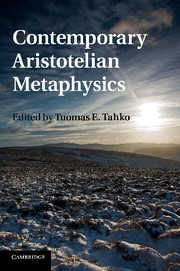Book contents
- Frontmatter
- Contents
- Contributors
- Preface
- Introduction
- Chapter 1 What is metaphysics?
- Chapter 2 In defence of Aristotelian metaphysics
- Chapter 3 Existence and quantification reconsidered
- Chapter 4 Identity, quantification, and number
- Chapter 5 Ontological categories
- Chapter 6 Are any kinds ontologically fundamental?
- Chapter 7 Are four categories two too many?
- Chapter 8 Four categories – and more
- Chapter 9 Neo-Aristotelianism and substance
- Chapter 10 Developmental potential
- Chapter 11 The origin of life and the definition of life
- Chapter 12 Essence, necessity, and explanation
- Chapter 13 No potency without actuality: the case of graph theory
- Chapter 14 A neo-Aristotelian substance ontology: neither relational nor constituent
- References
- Index
Chapter 14 - A neo-Aristotelian substance ontology: neither relational nor constituent
Published online by Cambridge University Press: 05 December 2011
- Frontmatter
- Contents
- Contributors
- Preface
- Introduction
- Chapter 1 What is metaphysics?
- Chapter 2 In defence of Aristotelian metaphysics
- Chapter 3 Existence and quantification reconsidered
- Chapter 4 Identity, quantification, and number
- Chapter 5 Ontological categories
- Chapter 6 Are any kinds ontologically fundamental?
- Chapter 7 Are four categories two too many?
- Chapter 8 Four categories – and more
- Chapter 9 Neo-Aristotelianism and substance
- Chapter 10 Developmental potential
- Chapter 11 The origin of life and the definition of life
- Chapter 12 Essence, necessity, and explanation
- Chapter 13 No potency without actuality: the case of graph theory
- Chapter 14 A neo-Aristotelian substance ontology: neither relational nor constituent
- References
- Index
Summary
Following the lead of Gustav Bergmann (1967), if not his precise terminology, ontologies are sometimes divided into those that are ‘relational’ and those that are ‘constituent’ (Wolterstorff 1970). Substance ontologies in the Aristotelian tradition are commonly thought of as being constituent ontologies, because they typically espouse the hylemorphic dualism of Aristotle’s Metaphysics – a doctrine according to which an individual substance is always a combination of matter and form. But an alternative approach drawing more on the fourfold ontological scheme of Aristotle’s Categories is not committed to this doctrine and may regard individual (or ‘primary’) substances as having no constituent structure, their only possible complexity residing in their possession, in some cases, of a multiplicity of substantial parts. However, as we shall see, this does not imply that such an ontology falls instead into the relational camp: for although it invokes, in addition to the category of individual substance, also those of substantial kind (‘secondary’ substance), attribute, and mode (or ‘individual accident’), it need not and arguably should not take there to be external relations between entities in the different categories. On this view, truths of exemplification and instantiation, such as ‘Dobbin is white’ and ‘Dobbin is a horse’, do not need relational truthmakers. Hence, it can be maintained that there are no such relations as ‘exemplification’ and ‘instantiation’, at most only certain relational truths of exemplification and instantiation – truths whose logical form is relational. This being so, I shall argue, such an ontology cannot fairly be classified as a ‘relational’ one.
Constituent versus relational ontologies
There is a common presumption that ontologies inspired by Aristotle are ‘constituent’ ontologies, whereas ones inspired by Plato are ‘relational’ – a presumption founded on the notion that Aristotle’s metaphysics is distinctively ‘immanent’ whereas Plato’s is distinctively ‘transcendent’. This way of putting matters is obviously rather crude and simplistic, but may still seem to capture an important difference. The immanent/transcendent distinction appears to come down to this: that the immanentist sees the properties of concrete objects as being ingredients of those very objects, whereas the transcendentist sees them as being separate entities to which the objects stand in some special relation of exemplification. By ‘properties’ in this context I mean to speak very broadly, to include not only features, such as redness or squareness, but also forms, such as humanity or equinity. Of course, some may hold that forms are merely combinations of features but others, including myself, certainly deny this. I am also assuming that, at this point at least, both features and forms are to be understood as being universals, rather than particulars, and in this respect unlike the concrete objects – or ‘individual substances’ – which ‘possess’ them. However, it is certainly open to a metaphysician to hold that features and forms are themselves particulars, or indeed to hold that features and forms come in two different varieties – the universal and the particular – so that, for example, as well as redness the universal feature we have a plurality of particular rednesses, a different one belonging to each individual substance that is red.
Keywords
- Type
- Chapter
- Information
- Contemporary Aristotelian Metaphysics , pp. 229 - 248Publisher: Cambridge University PressPrint publication year: 2011
- 8
- Cited by



